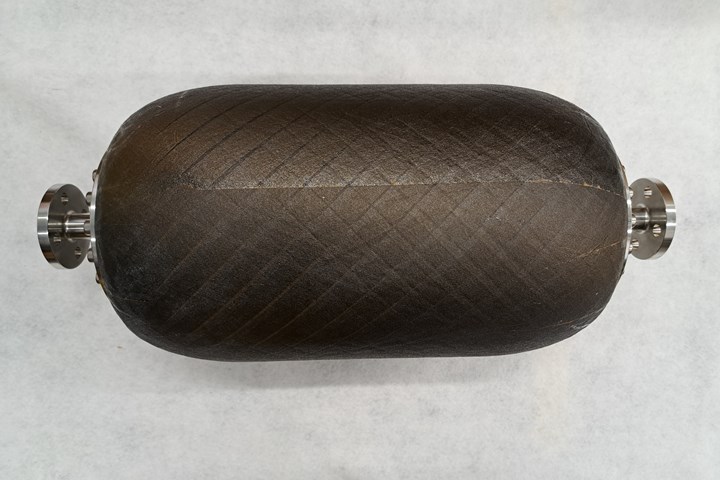NCC reaches milestone in composite cryogenic hydrogen program
The National Composites Centre is testing composite cryogenic storage tank demonstrators with increasing complexity, to support U.K. transition to the hydrogen economy.

The National Composites Centre (NCC, Bristol, U.K.) has announced a U.K.-based composite cryogenic storage tank testing program that will validate and accelerate design, manufacture and test capabilities, starting with a linerless carbon fiber tank for storing liquid hydrogen (LH2).
Cryogenic storage tanks will be essential components in hydrogen-powered aircraft due to come into service in the mid-2030s. Most designs for storing LH2 have centered around metallic tanks, which are relatively heavy. Composite tanks developed in the space industry tend to be suited only for single-use (low-cycle) applications. However, commercial hydrogen aircraft will need fuel tanks to be as light as possible, filled and emptied numerous times (high cycle), and last for several decades.
To support the U.K.’s transition to a low-carbon economy, the NCC is developing underpinning knowledge for composite cryogenic storage tanks and testing by developing product demonstrators with increasing complexity. Its team of specialist engineers have also created and built a range of comprehensive cryogenic concepting and design tools to help UK organizations overcome known engineering challenges critical to accelerating hydrogen development.
With no clear existing industry standards for aerospace cryogenic tanks, the ability to analyze a range of designs is essential. This led to the development of a range of concepting tools covering tank design space exploration, permeability, microcracking, thermal and mechanical stresses. These tools form a baseline toolset that can be used by industry for cryogenic tank projects, enabling detailed design and manufacturing risk identification and analysis. Understanding cryogenics at this fundamental level will enable the NCC to support a wide range of industries and applications, each facing separate but overlapping challenges.
Testing is a crucial part of the cryogenic tank development program, which currently requires access to specialist testing facilities. For example, LH2 requires well-insulated cryogenic storage vessels to maintain it at a temperature of -253°C, and handling requires specialist knowledge and equipment.
To develop a U.K.-based testing capability for its customers, the NCC has partnered with Filton Systems Engineering (FSE), a Bristol-based SME specializing in fluid system engineering, that owns and operates a hydrogen test facility capable of both gaseous and liquid hydrogen testing. Working in partnership with FSE, the NCC has developed a tank-testing program that uses an LH2 vacuum test chamber and cryo-rated testing instrumentation. As a world-leading composites research and development center, the NCC has designed and manufactured five linerless carbon fiber demonstrator tanks, using a mix of automated fiber placement (AFP), tape winding, and hand lay-up composite processes. The tanks will be used for the liquid hydrogen testing program, starting at the end of April 2023, with results expected summer 2023.
Daniel Galpin, Advanced Research Engineer, NCC, says, “The cross-sector capability we’ve developed will enable U.K. industry to accelerate and advance engineering expertise in composite cryogenic storage, and secure future commercial competitiveness. Our comprehensive program will enable us to support customers on their journey to design, validate, manufacture, and test high-cycle composite cryogenic tanks.”
The NCC Hydrogen team is collaborating with partners and the supply chain to advance engineering expertise in composite cryogenic storage systems that will help the U.K. to achieve its net-zero ambitions. This builds on NCC’s investment in capability development for hydrogen pressure vessels and hydrogen smart pipes: two other areas that will help establish a strong H2 supply chain as the Government implements its U.K. Hydrogen Strategy to kick-start a vibrant hydrogen economy by 2030. Expertise and knowledge developed through the focus on cryogenics has enormous potential for numerous cross sector applications and will guide technology development.
Related Content
Novel composite technology replaces welded joints in tubular structures
The Tree Composites TC-joint replaces traditional welding in jacket foundations for offshore wind turbine generator applications, advancing the world’s quest for fast, sustainable energy deployment.
Read MoreRecycling end-of-life composite parts: New methods, markets
From infrastructure solutions to consumer products, Polish recycler Anmet and Netherlands-based researchers are developing new methods for repurposing wind turbine blades and other composite parts.
Read MoreCollins Aerospace to lead COCOLIH2T project
Project for thermoplastic composite liquid hydrogen tanks aims for two demonstrators and TRL 4 by 2025.
Read MoreInfinite Composites: Type V tanks for space, hydrogen, automotive and more
After a decade of proving its linerless, weight-saving composite tanks with NASA and more than 30 aerospace companies, this CryoSphere pioneer is scaling for growth in commercial space and sustainable transportation on Earth.
Read MoreRead Next
All-recycled, needle-punched nonwoven CFRP slashes carbon footprint of Formula 2 seat
Dallara and Tenowo collaborate to produce a race-ready Formula 2 seat using recycled carbon fiber, reducing CO2 emissions by 97.5% compared to virgin materials.
Read MoreVIDEO: High-volume processing for fiberglass components
Cannon Ergos, a company specializing in high-ton presses and equipment for composites fabrication and plastics processing, displayed automotive and industrial components at CAMX 2024.
Read More“Structured air” TPS safeguards composite structures
Powered by an 85% air/15% pure polyimide aerogel, Blueshift’s novel material system protects structures during transient thermal events from -200°C to beyond 2400°C for rockets, battery boxes and more.
Read More
























